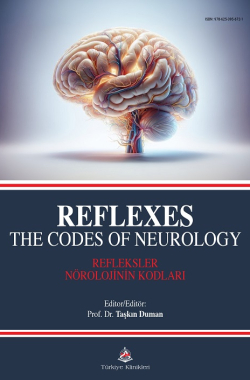THE CONCEPT OF REFLEX
Taşkın Duman1
Ali Özhan Sıvacı2
1Hatay Mustafa Kemal University Hospital, Department of Neurology, Hatay, Türkiye
2Bursa Yüksek İhtisas Training and Research Hospital, Department of Neurology, Bursa, Türkiye
Duman AT, Sıvacı AÖ. The Concept of Reflex. In: Duman T, editor. Reflexes The Codes of Neurology. 1st ed. Ankara: Türkiye Klinikleri; 2025. p.3-8.
ABSTRACT
For a neurologist, the concept of reflex, often regarded as the ‘alphabet of neurology’, represents one of the fundamental principles that help unravel the mysteries of phenomena encountered in clinical practice, whether developmental, physiological, or pathological, often appear as a code for a puzzle to be solved. understanding the concept of reflexes may be the first step in comprehending the nervous system, which is filled with highly complex reflexes.
Keywords: Reflex; Concept; Basic
Kaynak Göster
Referanslar
- Lewis CT, Short C. A Latin Dictionary. Oxford: Oxford University Press; 1879. [Crossref]
- Smith R. Optical reflection and mechanical rebound: the shift from analogy to axiomatization in the seventeenth century. Part 1. The British Journal for the History of Science. 2008;41(1):1-8. [Crossref] [PubMed]
- Crystal D, Alan CL, editors. A dictionary of linguistics and phonetics. John Wiley & Sons; 2023 Sep 19. [Crossref]
- Sutton J, McIlwain D, Christensen W, Geeves A. Applying intelligence to the reflexes: Embodied skills and habits between Dreyfus and Descartes. Journal of the British society for Phenomenology. 2011;42(1):78-103. [Crossref] [PubMed]
- James W. The principles of psychology. Henry Holt. 1890.
- Pearce JM. Marshall Hall and the concepts of reflex action. Journal of Neurology, Neurosurgery, and Psychiatry. 1997;62(3):228. [Crossref] [PubMed]
- Pavlov PI. Conditioned reflexes: an investigation of the physiological activity of the cerebral cortex. Annals of neurosciences. 2010;17(3):136. [Crossref] [PubMed]
- Dostoevsky F. Notes from the Underground. Broadview Press; 2014 Aug 27. [Crossref] [PubMed]
- Waggoner HH. TS Eliot and the Hollow Men. American Literature. 1943;15(2):101-26. [Crossref] [PubMed]
- Bröndum K. The Blurring of Human and Artificial Intelligence in Philip K. Dick’s Do Androids Dream of Electric Sheep. [Crossref]
- Clark A, Chalmers D. The extended mind. InterAction. 2016;8(1):48. [Crossref]
- Jennings HS. The behavior of Paramecium. Additional features and general relations. Journal of Comparative Neurology and Psychology. 1904;14(6):441-510.
- Häder DP, Iseki M. Photomovement in Euglena. Euglena: biochemistry, cell and molecular biology. 2017:207-35. [Crossref] [PubMed]
- Yamamoto W, Yuste R. Whole-body imaging of neural and muscle activity during behavior in Hydra vulgaris: effect of osmolarity on contraction bursts. Eneuro. 2020;7(4). [Crossref] [PubMed]
- Wicht H, Lacalli TC. The nervous system of amphioxus: structure, development, and evolutionary significance. Canadian Journal of Zoology. 2005;83(1):122-50. [Crossref] [PubMed]
- Patestas MA, Gartner LP. A textbook of neuroanatomy. John Wiley & Sons; 2016 May 2. [Crossref]
- Jakobi JM, Kohn S, Kuzyk S, Fedorov A. When Kicking the Doctor Is Good-A Simple Reflex. Neuroscience. 2017;5(10):1-8. [Crossref] [PubMed]
- Futagi Y, Toribe Y, Suzuki Y. The grasp reflex and moro reflex in infants: hierarchy of primitive reflex responses. International journal of pediatrics. 2012;2012(1):191562. [Crossref] [PubMed]
- Klein C, Barron AB. Insects have the capacity for subjective experience. Animal Sentience. 2016;1(9):1. [Crossref]
- Takanami K, Oti T, Kobayashi Y, Hasegawa K, Ito T, Tsutsui N, Ueda Y, Carstens E, Sakamoto T, Sakamoto H. Characterization of the expression of gastrin-releasing peptide and its receptor in the trigeminal and spinal somatosensory systems of Japanese macaque monkeys: Insight into humans. Journal of Comparative Neurology. 2022;530(16):2804-19. [Crossref] [PubMed]
- Guggisberg AG, Mathis J, Schnider A, Hess CW. Why do we yawn?. Neuroscience & Biobehavioral Reviews. 2010;34(8):1267-76. [Crossref] [PubMed]
- Steger M, Schneemann M, Fox M. Systemic review: the pathogenesis and pharmacological treatment of hiccups. Alimentary Pharmacology&Amp; Therapeutics 2015;42(9):1037-1050. [Crossref] [PubMed]
- Ishiyama S. and Brecht M. Neural correlates of ticklishness in the rat somatosensory cortex. Science 2016;354(6313):757-760. [Crossref] [PubMed]
- Proelss S, Ishiyama S, Maier E, Schultze-Kraft M, Brecht M. The human tickle response and mechanisms of self-tickle suppression. Philosophical Transactions of the Royal So- ciety B: Biological Sciences 2022;377(1863). [Crossref] [PubMed]
- Wattendorf E, Westermann B, Fiedler K, Ritz S, Redmann A, Pfannmöller J. et al. Laughter is in the air: involvement of key nodes of the emotional motor system in the anticipation of tickling. Social Cognitive and Affective Neuroscience 2019;14(8):837-847. [Crossref] [PubMed]

